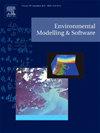A two-stage trained hybrid Unet-ConvLSTM2D for enhanced precipitation nowcasting
IF 4.6
2区 环境科学与生态学
Q1 COMPUTER SCIENCE, INTERDISCIPLINARY APPLICATIONS
引用次数: 0
Abstract
Current precipitation nowcasting models such as ConvLSTM, ConvGRU, PredRNN, and PFST-LSTM face challenges in capturing complex spatiotemporal patterns and preserving fine spatial details. These models often struggle with high-intensity precipitation events and lose accuracy over longer lead time. Although PFST-LSTM addresses spatial alignment and feature preservation and SAC-LSTM enhances long-range spatial dependency modeling through self-attention, they are constrained by increased computational complexity. In this study, we propose a hybrid Unet-ConvLSTM2D model that combines Unet’s superior spatial feature extraction capabilities with ConvLSTM2D’s temporal sequence modeling strengths. By introducing time-distributed layers in each Unet block, the model effectively handles temporal sequences while retaining high-resolution spatial features. The model is trained using a two-stage approach: pre-training on the moving-MNIST++ dataset to learn basic temporal dynamics, followed by fine-tuning on the CIKM AnalytiCup 2017 dataset to adapt to real-world meteorological data. Experimental results demonstrate that the proposed model significantly outperforms existing methods, with average improvements of 3.73% in critical success index (CSI) and 3.63% in Heidke skill score (HSS) across all dBZ thresholds, along with a 4.72% reduction in mean squared error (MSE).

用于增强降水临近预报的两阶段训练混合Unet-ConvLSTM2D
当前降水临近预报模型如ConvLSTM、ConvGRU、PredRNN和PFST-LSTM在捕获复杂时空模式和保留精细空间细节方面面临挑战。这些模型经常与高强度降水事件作斗争,并且在较长的前置时间内失去准确性。尽管PFST-LSTM解决了空间对齐和特征保存问题,而SAC-LSTM通过自关注增强了远程空间依赖建模,但它们受到计算复杂性增加的限制。在本研究中,我们提出了一种混合Unet-ConvLSTM2D模型,该模型结合了Unet优越的空间特征提取能力和ConvLSTM2D的时间序列建模优势。通过在每个Unet块中引入时间分布层,该模型在保留高分辨率空间特征的同时有效地处理时间序列。该模型采用两阶段方法进行训练:在moving-MNIST++数据集上进行预训练,以学习基本的时间动态,然后在CIKM AnalytiCup 2017数据集上进行微调,以适应现实世界的气象数据。实验结果表明,该模型显著优于现有方法,在所有dBZ阈值下,关键成功指数(CSI)和Heidke技能分数(HSS)平均提高了3.73%,均方误差(MSE)平均降低了4.72%。
本文章由计算机程序翻译,如有差异,请以英文原文为准。
求助全文
约1分钟内获得全文
求助全文
来源期刊

Environmental Modelling & Software
工程技术-工程:环境
CiteScore
9.30
自引率
8.20%
发文量
241
审稿时长
60 days
期刊介绍:
Environmental Modelling & Software publishes contributions, in the form of research articles, reviews and short communications, on recent advances in environmental modelling and/or software. The aim is to improve our capacity to represent, understand, predict or manage the behaviour of environmental systems at all practical scales, and to communicate those improvements to a wide scientific and professional audience.
 求助内容:
求助内容: 应助结果提醒方式:
应助结果提醒方式:


